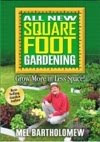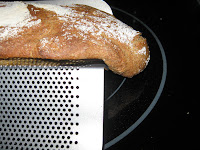According to WiseGeek rye has been cultivated for more than 4,000 years. The article notes that"[r]ye is far more tolerant to poor growing conditions than wheat, and it grows in soil of low quality where other grains will not. In addition, rye is able to withstand prolonged submersion in water as well as drought." Sounds pretty great. But rye has a dark side.
Rye is highly susceptible to the ergot fungus. And when ergot infected rye is consumed it can lead to a variety of ailments, including "convulsions, miscarriage, necrosis of digits, and hallucinations." Wikipedia notes that "[h]istorically, damp northern countries that have depended on rye as a staple crop were subject to periodic epidemics of this condition." Ergotism was more common historically, but it has also occurred more recently. According to a lecture given by Dr. George J. Wong, Associate Professor of Botany at the University of Hawai'i, "Ergotism occurred in 1926-27 in Russia, with 10,000 reported cases, in England in 1927, with 200 cases, among central European Jewish immigrants," and there was an outbreak in France in 1951.
There is a theory that consuming ergot infected rye was a factor in the Salem Witch Hysteria, see, for example, Bad Rye and the Salem Witches. Though this theory sounds far-fetched, has been hotly disputed, and cannot be proven, the outbreak of ergot poisoning in Pont-Saint-Esprit, France in 1951 is interesting in that regard.
Time Magazine wrote on Monday, September 10, 1951 in an article on the French outbreak titled St. Anthony's Fire that "Pont-Saint-Esprit speculated that the village idiot had hexed [the baker's] flour." Sounds like the work of witches--or warlocks.
In fact, tests determined that it was ergot poisoning. The Time article concluded "Pont-Saint-Esprit had been stricken by ergot poisoning, a medieval disease as old as its proud bridge, so old that it had almost been forgotten." Despite the conclusion of the medical experts of the time, as reported by Time, there is a counter view to the diagnosis of ergot poisoning in Pont-Saint-Esprit. The CIA did it! See Was idyllic French village driven crazy by LSD in a secret American mind experiment? CIA. Witches. To-mā-tō. To-mah-tō.
Anyway, as all who know me can attest, I laugh in the face of danger (or at least giggle nervously), so risk of ergot poisoning or no, I forged ahead. OK. Actually, according to Dr. Wong, the outbreak in Pont-St. Esprit in 1951 was the last known example of ergotism. Dr. Wong notes that "[t]hrough careful screening out of the ergot stage, ergotism is now rare. To clean Rye seeds, a floatation method has been devised. A solution of approximately 30% potassium chloride is poured over the Rye seeds and stirred. The ergot stage is buoyant and will float to the top and can be skimmed off." But I still laugh in the face of danger.
 I first baked the Whole Grain Rosemary Potato Dinner Rolls with a Salt Crust. They contain chunks of raw potato, which made them look a bit funny. On first glance some of my testers thought they were cookies (though perhaps that was just wishful thinking). For the salt crust I blitzed the rosemary and the salt together in a mini-food processor, stealing an idea from an episode of Diners, Drive-ins and Dives. I was careful with the amount of rosemary, since it can be strong, but I needn't have worried, it was very muted, which is typical when using whole grain flour, as we have often noted. I thought the rolls were OK, but nothing that knocked my socks off. And I am still not sure about the chunks of potato.
I first baked the Whole Grain Rosemary Potato Dinner Rolls with a Salt Crust. They contain chunks of raw potato, which made them look a bit funny. On first glance some of my testers thought they were cookies (though perhaps that was just wishful thinking). For the salt crust I blitzed the rosemary and the salt together in a mini-food processor, stealing an idea from an episode of Diners, Drive-ins and Dives. I was careful with the amount of rosemary, since it can be strong, but I needn't have worried, it was very muted, which is typical when using whole grain flour, as we have often noted. I thought the rolls were OK, but nothing that knocked my socks off. And I am still not sure about the chunks of potato.Since I had a half batch left, I used it to make a type of foccacia. I let it rise about 20 minutes, spritzed it with olive oil before sprinkling with my rosemary salt, and baked it at 425. They did not rise much, but were tasty used for blackened tilapia sandwiches. (The orange and yellow strips on the plate are peppers which I picked, and packed and pickled.)


For the Dilled Rye with White Whole Wheat I used dried dill from the garden, and doubled the amount. I still did not get much, if any, dill flavor. The bread was good, however, though without caraway it just did not seem to me like a rye. WiseGeek notes that "[r]ye has a very strong flavor, which some people find offensive to the taste." Although breads used to be made from 100% rye flour, because of its strong flavor it is now usually mixed with wheat flour. I did not notice a strong flavor, "rye" or otherwise, in this bread. Maybe I will try HB in 5's 100% Whole Wheat, Plain and Simple with all rye some time.


Since, as you can see from the pictures, my first loaf spread quite a bit, even though I used my 2x2 couche to keep it in check while rising, I baked the second loaf in my new perforated french bread pan. I also patted the dough out, sprinkled on another dose of dill, and rolled it into a log to rise.

 It came out nicely, and tasted good, but I still did not taste dill. Maybe fresh dill would have done better, but my dill is under 1 1/2 feet of snow right now....
It came out nicely, and tasted good, but I still did not taste dill. Maybe fresh dill would have done better, but my dill is under 1 1/2 feet of snow right now....Well, that is it for this time. We go gluten-free next time, so be sure to check back on February 1st.


















